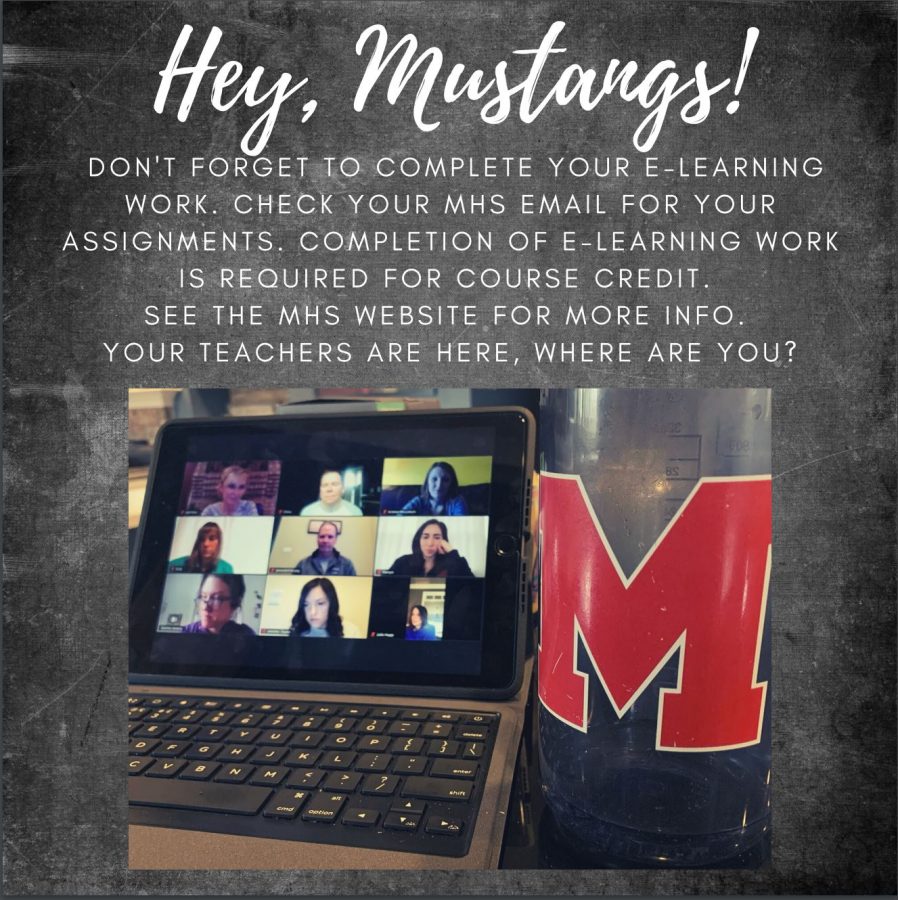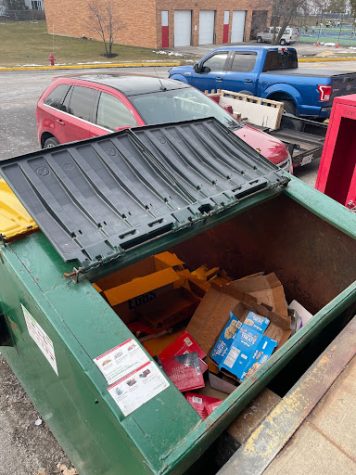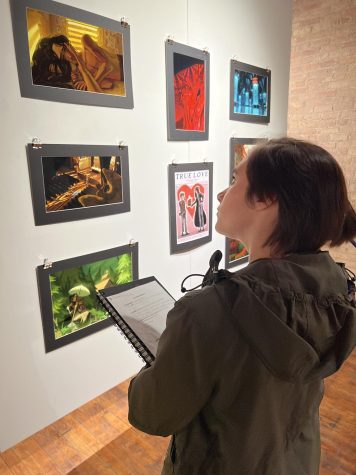COVID-19: Impact on MHS
Social Studies Teacher Mary Plucinski created this graphic as part of the school’s social media campaign to get students engaged in eLearning during the shelter-in-place state government directive, which was issued in response to the COVID-19 pandemic.
April 14, 2020
Friday, March 13, is a day that will continue to weigh on the minds of MHS students, as it was the last day of school before the school community transitioned to eLearning due to COVID-19, an infectious disease that was unknown until a breakout occurred in Wuhan, China, in Dec. 2019. The global spread of the disease led the World Health Organization to declare the situation a pandemic on March 11.
On that last day of school before the transition to eLearning, rumors floated around the building about what the eLearning experience would be like, and the feeling of uncertainty was ever-present.
“I remember having a sub in my math class second period, and he was explaining how this would all blow over, but then everyone came to a realization of what was actually happening,” junior Parker Neumaier said. “I also remember telling my friends that I’ll see them on Monday and can’t wait to go to lunch together and hang out, but it never happened.”
As the day came to a close, students wondered what the rest of the year would look like and how long they would be gone. Teachers considered how they would continue their curriculum, and after the last bell rang for the day, security ushered students, who were carrying the vast majority of their lockers’ content, sports equipment and instruments, out of the school as quickly as possible.
School moves online
It was a confusing day for many and the start of an unprecedented event– a social-distancing state government mandate that shut down the schools and forced MHS administration to plan for an extended closure in a very short amount of time.
“While we did already have an eLearning plan in place that was approved by our Board of Education this past fall, we really only had a day and a half to prepare for what now is a long school closure,” Stacey Gorman, assistant principal of teaching and learning, said in an email. “We had to make sure students had working Chromebooks, chargers, textbooks, copies of any necessary materials, etc. The Mundelein Staff [has been absolutely amazing]; they changed all their plans and started planning for remote learning.”
While MHS staff has received some training to set up eLearning, they have not been trained to execute eLearning curriculum for extended periods of time. As a result, the adjustment to the eLearning teaching environment has been difficult for teachers.
“Our eLearning plan we originally wrote was for one-to-two emergency weather days, maybe four at most. Teachers had ideas for eLearning lessons that would help students get through a few days until they could come back to school and get caught up,” Gorman said. “The type of eLearning we are doing now is requiring teachers to develop a new approach to learning when students are not in the classroom every day. Teachers are spending countless hours creating new lessons that will engage students remotely during this time.”
Teachers, students react to eLearning
U.S. History Teacher and Current World Issues Teacher Nicole Malham has spent many hours developing lesson plans. She hopes it will create a meaningful learning experience for her students at home while limiting the negative impact on students not being in school.
“Obviously, this will have an impact on learning at the start of the school year next year since students will have a gap in their learning,” Malham wrote in an email. “I am very hopeful that this will not encourage a shift towards more eLearning instead of a traditional classroom learning environment.”
Freshman English Teacher and AP Literature Teacher Mike Dayton also said he was trying to adjust to the lack of student interaction offered through eLearning that he normally gets with students in a traditional classroom setting.
“I like the personal interaction with students, so I was bummed when I heard we had to close,” he said via email. “There is a real excitement in being around other people, and community is a huge part of learning, but I’m glad the school made the decision it did because it is what is best for everyone.”
Dayton also acknowledged that this switch to eLearning might have an effect on school and how lessons are presented in the future.
“I don’t think we are going to realize how [this eLearning time] has changed the system until this is over,” he said. “In the short term, it has forced students and teachers to learn how to ‘play’ school in an entirely different manner. I don’t think the lack of personal interaction is a good thing for anyone, though.”
Students also find the lack of face-to-face instruction time difficult.
“I think eLearning will worsen our education because it’s not as helpful as being in a classroom surrounded by other students and a teacher,” senior Maya Skowronski stated in an email where she also wrote, “The biggest downfall of eLearning is not having a teacher to answer your questions in real time. Also, it’s harder to talk to your peers about topics from home.”
James Doyle, AP Biology teacher, also explained how the eLearning process is challenging for science classes, as the learning typically done in a science classroom is not as easily transitioned to online.
“Science eLearning is a real challenge because science is meant to be done, not just read about. It is also meant to be a community activity, which is challenging in this situation,” Doyle said through an email.
While eLearning has had its hardships, some students have seen a positive impact on their learning.
“eLearning has allowed me to be more motivated in certain subjects as I have been able to produce more quality work and writing,” freshman Riley Hodel said through email.
Effects on extracurriculars
Besides adjusting to learning online, the school community has also had to adjust to cancelled and/or postponed events, such as prom and graduation.
Principal Dr. Anthony Kroll said in a March 30 email to the community that school administration will consider what is best for students given the circumstances before making any decisions about how to proceed with traditional spring activities.
“The building administration will be reviewing options for each end of the year event (graduation, prom, senior honors night) in light of the different considerations. As we hold these discussions, our first objective is to hold the event if at all possible. If the event is not able to be held, our goal is to hold a type of virtual event if appropriate and/or possible,” wrote Dr. Kroll, who also said in the same email, “Until we hear more from the governor regarding the length of the school closure, we will not make any hard and fast decisions regarding any end of the year events. Therefore, any decisions regarding whether these end of the year events will be held, rescheduled or cancelled will weigh heavily on our hearts and minds.”
While no firm decisions have been made, many students, especially seniors, are disappointed by the effect the pandemic is having on the end of the year.
“My biggest fear is prom and graduation getting cancelled,” Skowronski said. “I’d rather have prom and graduation postponed to June than not have them at all.”
Besides senior events being affected by the social-distancing order so have extracurricular activities like spring sports.
“We worked really hard and were expecting a fun season together, but we don’t get that experience now,” said Lauren Geary, sophomore varsity water polo player.
Geary added she had been excited for her second year on varsity for this sport, as this season was expected to bring triumphs for the team based on the skill level of the players.
However, now her season, and every other student-athlete’s spring season is unknown; there has been very little information about what will happen to the spring sports season.
“I only get four years of this sport I love, and now this year is taken away from me,” Geary said.
Other extracurricular activities, such as the spring musical, have been affected, too.
The Mundelein Theatre program had plans to perform “Guys and Dolls” toward the end of April, but this has been postponed since the shelter-in-place deadline was extended until April 30. Theatre Director Jonathan Meier said the impact on the show has put the old phrase “the show must go on” to the test and also said the cast has been actively rehearsing and working just as hard as if they were in school.
“We have stayed pretty active with our rehearsal process,” he said. “Fortunately, we have technology on our side. All cast members have an app called RehearScore, which provides them with the music for the show, so they can continue to work on their music. Our choreographer has been on Facebook Live teaching the choreography.”
As a result, the Mundelein Theatre musical has not been officially canceled yet. Meier expressed hope of being able to have the cast perform this classic musical over the summer with no set date yet in mind.
Meier noted this is not the first time in Mundelein Theatre’s history where a musical has been rescheduled for the summer.
“We do have a history of mounting musicals in non-traditional ways,” he said. “Several years ago, we remounted our musical over the summer when a cast member got sick and was unable to perform in the original production.”
Meier said he plans to use that experience to get “Guys and Dolls” up and running. In the meantime, the cast has remained strong.
“The spirit and energy of the Mundelein Theatre students has shown through,” Meier said. “We are making the best of a tough situation.”
MHS, Mundelein Community Work Together
While events may have been cancelled or postponed, public services for those in the Mundelein community have continued.
“Police, fire, public works, water, sewer service– it all must continue…. The Village is closed to the public, but we still process water bills, permits, and licensing,” Mundelein Mayor Steve Lentz said in an email, where he also stated citizens who have questions regarding municipal services can call Village Hall at 847-949-3200.
Lentz, who tested positive for COVID-19, also had a specific message for how teenagers can protect themselves from catching the virus.
A trending recreational activity for some teens in high school is to smoke or vape, which is linked to COVID-19 complications for younger patients.
At the time of the interview, Lentz said his daughter had a 20-year-old friend who had been on a ventilator for days in a forced coma and was “currently fighting for her life; she smoked a lot of weed, and that, no doubt, contributed to her complications.”
The mayor also said parents should influence their kids to not smoke or vape, which could further protect them from COVID-19.
“I’d encourage parents to embrace the awkward one-on-one conversations with their children about vaping and smoking weed; the stakes are so much higher now,” Lentz said.
For more information about COVID-19 and other ways people can protect themselves from the virus, visit the Lake County Health Department website.
Besides helping people have access to quality information about COVID-19, the Mundelein community and MHS are also working together to help families who depend on the school for meals.
“Schools don’t just provide education, and for a portion of our student body, the only quality meals they get on a regular basis are from the cafeteria. MHS also came together in a major way to continue to provide resources like food and supplies to our families in need,” Doyle said.
There are designated spots around Mundelein where those below the age of 18 are able to get free meals a few times a week. If in need of resources, more information can be found on the D120.org extended eLearning website.
While the shelter-in-place order has been difficult for many, public officials continue to emphasize the following:
- Stay home to help prevent the spread of COVID-19. At the April 4 Coronavirus government task force conference, government scientists predicted the number of deaths from COVID-19 will rise dramatically during the month of April.
- Wear masks in public spaces, according to the Centers for Disease Control and Prevention.
- After going out, wash your hands with soap and water for 20 seconds– a simple but effective preventative technique, according to public health officials.
The Future
While no one knows for sure what course this virus will take and when the public will see the numbers of those infected by the virus start to diminish, there are some predictions about when society will return to more normal routines.
Doyle said the virus is predicted to peak in Illinois in late April with other states possibly peaking in May or later. Doyle also emphasized that this all depends on how people adhere to the social-distancing guidelines.
“I would guess that we could be back to normal by the end of summer, but it depends on a lot of factors. If people shelter-in-place properly and don’t get together in groups for ‘coronavirus parties,’ then August or September may see us back in schools and off to colleges,” he said.
Additionally, there are positive aspects of this virus– humans have the ability to create vaccines to combat it, and once a person gets a virus, they are never able to become infected by that same virus again.
“Viruses that are stable and don’t mutate much are ideal for vaccines because they don’t change the way they look, and the immune system can recognize it even after decades,” Doyle said. “The coronavirus that causes COVID-19 is very stable, and mutations are quite rare, which makes it ideal for vaccine development.”



